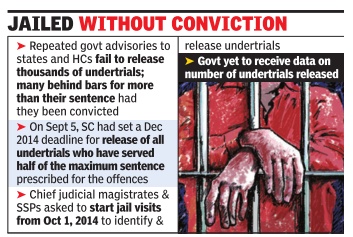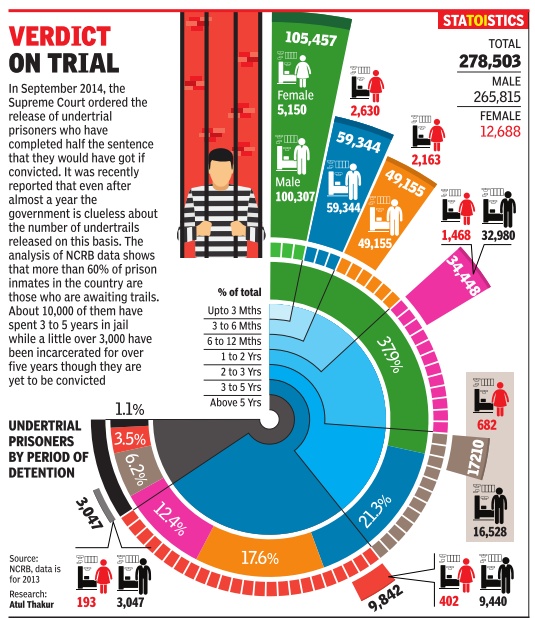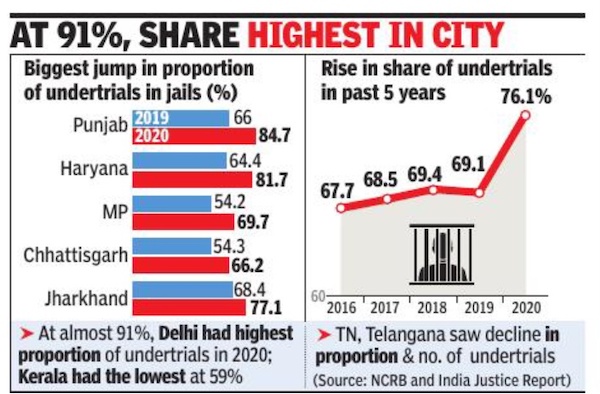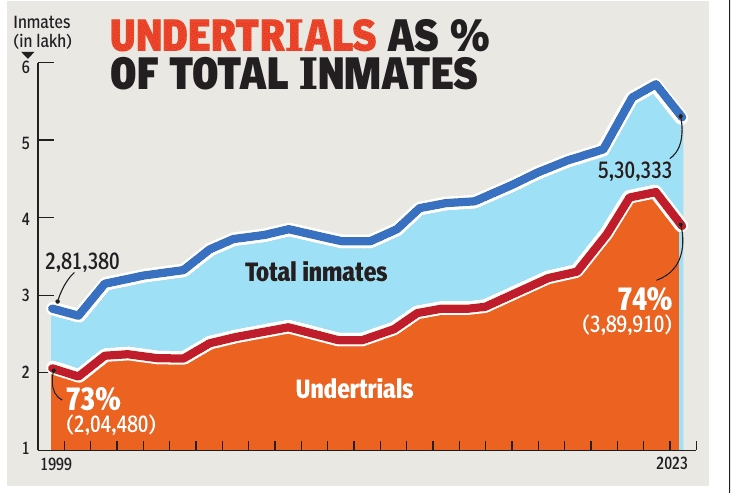Undertrial prisoners: India
This is a collection of articles archived for the excellence of their content. the Facebook community, Indpaedia.com. All information used will be acknowledged in your name. |
Contents |
The extent of the problem
1998-2017
Atul Thakur, NOv 20, 2019: The Times of India

Their age profile
Duration of their imprisonment without conviction
From: Nov 7, 2019: The Times of India
See graphic:
Undertrials in jail, 1998-2017
Their age profile
Duration of their imprisonment without conviction
It is not the prisoners who need reformation, it is the prisons - Oscar Wilde said, after spending two years in prison for indecency. The quote aptly sums up the situation of Indian prisons that are overcrowded and understaffed. Only a third of those imprisoned are convicted offenders, while an overwhelming majority are still awaiting trial — the number is as high as 80% in states like Bihar and J&K . Worse, a vast majority of prisoners cannot afford legal help. Latest figures released by the National Crime Records Bureau (NCRB) reveal just how deep the problems are with India’s prisons.
The majority of these undertrials come from the age group that is economically most active i.e. 18-50 years. A mechanism for speedy trials could have ensured against the loss of productivity that this entails.
Although the highest proportion of undertrial inmates are those who are jailed for less than three months, there are many who have had to spend a much longer duration in prison. In 2017, there were 4,876 prisoners who were jailed for more than five years and were still going through with their trials.
Bihar is the worst offender with undertrials comprising 84% of those lodged in jails. The situation is equally abysmal in states like Jammu and Kashmir and Delhi where over 80% of the inmates are still awaiting trials.
According to the NCRB report, the number of crimes has risen in India, however, surprisingly, the number of jails has decreased by 4% between 2016 and 2017. In a special mention, the report singles out Maharashtra, where out of 100 sub-jails, only 43 were active, while the remaining 57 have been shut down. It’s not like the existing prisons in India aren’t filled to the brim — occupancy rates across India’s correctional facilities would be the envy of India’s 5-star hotels as prisons continue to remain overcrowded.
OVERCROWDING IN INDIAN JAILS
The capacity of Indian jails’ has not kept pace with the rise in crime rate and overpopulated states are the worst affected. On an average, jails in India have more inmates than the sanctioned strength and though there has been a slight decrease in overcrowding, jails are still overflowing — the occupancy rate of 115% means there are 15 additional prisoners for every 100.
Of the total 4.5 lakh prison inmates, a little over 4 lakh or 89% are lodged in district and central jails. In 2017, district jails were operating at 129% of their actual capacity, while central jails were operating at 118%. The number of detainees increased from 3,85,135 in 2012 to 4,50,696 in 2017 showing a rise of 17%.
With an occupancy rate of 165%, jails in UP are the country’s most overcrowded. Naxal-hit Chhattisgarh also has a high occupancy rate of 157.2%.
If overcrowding wasn't bad enough, most jails are understaffed. Overall, jails are operating at 68.8% of their sanctioned strength. Vacant posts in jail administration constitute a major challenge for prisons across India. Though, there has been an increase in staff every year since 2013, it has not kept up with the sanctioned strength. Jharkhand fares by far the worst in this respect, as only 33.5% sanctioned posts have been filled in the state. Not surprisingly, the ratio of inmates per prison staff in the state is the worst by quite a distance.
State-wise comparison shows that in 2017, jails in Jharkhand had the highest proportion of vacancy as the state was operating with only 33.5% of the sanctioned staff. The state has 21 prisoners for every staff member, the second-worst state being Uttar Pradesh, which has 14 prisoners for every staff member. On the other hand, almost all sanctioned posts in Nagaland (99.5 %) have been filled. The state has one inmate for every prison staff member.
IN 7 YEARS, NO ONE CONVICTED FOR 700 DEATHS IN POLICE CUSTODY
Every year nearly 100 people die in police custody. What’s worse, there hasn’t been a single conviction for such deaths since 2011. Andhra Pradesh had the highest cases of custodial deaths followed by Maharashtra.
While there are a number of instances of policemen getting chargesheeted in custodial death cases, convictions are rare. Low convictions are partly explained by the declared causes of death.
States like Maharashtra and Kerala have a better than average conviction rate of above 50%. In 2017, Maharashtra had the highest rate of conviction and Andhra Pradesh completed the maximum number of trials.
Undertrials, pending: 2013
Pradeep Thakur, May 8, 2018: The Times of India
May 08 2015


At least 2.54 lakh undertrials, many of whom may be innocent, are made to languish behind bars for their failure to procure bail.
It has been estimated that out of 3.81 lakh prisoners across the country , about 2.54 lakh are undertrials. Only one-third, or 1.27 lakh, of those in jail have been convicted and are serving their sentence. In British India, the ratio of undertrials to convicts was just the reverse, where two-thirds of the prison population was of convicts. According to the government's own assessment, many of these undertrials have spent more time in jail than the sentence they would have got had they been convicted for the crime they were arrested for, which is against the law of the land.
Some of these undertrials are petty thieves and ragpickers and can't afford bail bond.In many cases, undertrials have been jailed for more than a decade without cases being listed for trial. In September 2014, the SC had set a deadline of December 2014 to release all undertrials who had served half of the maximum sentence prescribed for the offences they had been charged with in FIR against them on personal bond. Prior to the SC order, the home ministry too had issued advisories to states and all 24 HCs asking them to ensure implementation of Section 436A of the Code of Criminal Procedure that mandates release of such undertrials.
But this was not the first time that the government had raised the matter with state governments and high courts and brought to their notice the CrPC provisions. “Such advisories were sent to state governments and HCs earlier to implement the amendment brought in CrPC but this was never followed,“ a source said.
2016-2020
Atul Thakur & Rema Nagarajan, February 14, 2022: The Times of India

From: Atul Thakur & Rema Nagarajan, February 14, 2022: The Times of India
The number of undertrials in prisons rose sharply in 2020 even as the number of convicts fell, resulting in undertrials accounting for over three-fourths of all those in jail, the highest proportion in at least a decade.
The year also showed a significant decline of 2. 6 lakh in the number of undertrials released on bail compared to 2019. This could be due to lower access to the judiciary in 2020, as indicated by an overall decrease in the number of visits to courts from jails in many states. However, the pattern varies from state to state as many organised video conferenecing facilities for hearings in jails and reduced the number of convicts in the inmate population, resulting in the proportion of undertrials increasing. These facts emerge from data given by NCRB and analysed by India Justice Report.
1999-2023
Atul.Thakur, Oct 4, 2025: The Times of India

From: Atul.Thakur, Oct 4, 2025: The Times of India
Around three-fourth of all prison inmates in India in 2023 were undertrials, according to the latest report released by National Crime Records Bureau (NCRB). The numbers are staggering: India has 5.3 lakh people in jail; of them, 3.9 lakh are yet to be convicted — they are on trial.
But this is actually an improvement over the previous years. The percentage of incarcerated undertrials in 2021 was 77%. This fell to 76% in 2022, and then to 74% in 2023. Of these undertrials, 150 died while in jail; 64% of them were suicides.
The share of undertrials in jail keeps fluctuating, but an analysis of the data for the past 25 years shows it has never dropped below 65%. Several studies have suggested that delays in investigation, shortage of judges, and lack of access to legal aid because of poverty are the main reasons why undertrials end up spending a long time in prisons. There are 3.6 crore pending criminal cases in district courts, 17.5 lakh cases in high courts and 14,667 cases in the Supreme Court.
In answer to a Parliament question last Feb, it was revealed that the judge-to-population ratio in India is estimated at 21 judges per million population, which is less than half of what the Law Commission recommended in its 120th report.
With so many undertrials in jail, our prisons have also become overcrowded. Although the occupancy rate has improved from 131% in 2022 to 121% in 2023, jails have more inmates than their sanctioned capacity and this has been the case for the past 25 years. Twenty years ago, the situation was even worse as the occupancy rate had touched 145% in 2005. Since then, jails have been equipped to handle 1.9 lakh more prisoners, but that has clearly not been enough.
60% of undertrials spend more than three months in jail
Deeptiman Tiwary, May 11, 2015: The Times of India
According to government data, over 60% of undertrials spend more than three months in jail before they can secure release. The prolonged incarceration is due to the inability of these undertrials to get bail.
Close to 1.75 lakh of 2.78 lakh people facing criminal charges are unable to secure bail before three months. Over 40% (1.1 lakh) of undertrials take more than six months to secure bail, while over 30,000 spend more than two years and over 64,000 spend more than a year in jail before they are released on bail.
The figures point to a deeper malaise in the criminal justice system as bail, pending conviction, is considered a right under Indian law. Even in cases of heinous nature, an undertrial is entitled to bail, if not immediately, then after a chargesheet is filed by an investigating agency . Police get three months to file charges in cases under the Indian Penal Code and up to six months under special laws such as Unlawful Activities Prevention Act and Maharashtra Control of Organized Crime Act.
The fact that over 60% are incarcerated even after charges are filed points to the fact that only those with deep pockets to hire talented lawyers and fight long-drawn legal battles are able to secure bail.
Colin Gonsalves of Human Rights Law Network said that though bail was a right of every individual, it was largely available to the rich. “When it comes to rich people, the court has double standards. The rich even get anticipatory bail. Salman's case is a shocking case of miscarriage of justice and consideration based on class. First, it's a fit case where he should have got 10 years in jail. Two, why should his bail plea be heard expeditiously when there are hundreds such applications pending in high courts. Why should he be allowed to jump queue? It sets a bad precedent,” he told TOI.
Procedures
Handcuffing without recording reason in case dairy
Vasantha Kumar, June 29, 2022: The Times of India
Bengaluru:No person, be it an accused, undertrial prisoner or convict, should be handcuffed unless the reason for it is recorded in the case dairy, the Dharwad bench of the Karnataka high court ruled in a recent judgment and granted the petitioner Rs 2 lakh compensation. Suprit Ishwar Divate, a resident of Yadur in Belagavi district, had sought Rs 25 lakh compensa tion for loss of reputation, illegal detention and illegal handcuffing by police against him on November 5, 2019. However, ruling that the arrest was proper as it was based on a no nbailable warrant, the HC directed the state government to pay Divate Rs 2 lakh as compensation within six weeks with liberty to r ecover it from delinquent officers.
Justice Suraj Govindaraj said if an accused is produced before a court after arrest, it would be the court’s duty to inquire if the person had been handcuffed. “If the person responds in the affirmative, the court would have to ascertain the reasons for handcuffing and decide on its validity,” the judge observed in his order. A similar process would have to be followed for an undertrial prisoner. “The trial court shall endeavour as far as possible to avoid physical appearance of the undertrial prisoner and permit appearance through video-conferencing,” he added. He also said, permission to handcuff an undertrial prisoner would have to be taken before producing the person before the court and an order must be secured. “If no permission is applied for and undertrial was to be han dcuffed, the police officer would be at risk of handcuffing being declared illegal and action being taken against him or her. ” Negating the government’s contention that Divate’s handcuffing was resor ted to since there were not enough police personnel to prevent his escape as “no excuse at all”, Govindaraj noted that the government should equip all stations with adequate staff.
Religion-wise composition
2020
New Delhi : Around 19. 5% of undertrials lodged in India’s jails as on December 31, 2020, belonged to the Muslim community, while 67% were Hindus, 3. 5% Sikhs, 2. 2% Christians and the remaining, from ‘other’ religions, the MHA told Rajya Sabha on Wednesday, reports Bharti Jain. As per Census 2011, the share of Hindus in India’s population was 79. 8%, that of Muslims 14. 2%, Sikhs 1. 7% and Christians, 2. 3%. NCRB data cited by junior home minister Nityanand Rai shows that as on December 31, 2020, Muslims constituted nearly 64% of the undertrial prisoners’ population in the Muslim majority state of J&K, even as Assam had more Muslims serving prison as undertrials (52%) than Hindus (41%). In absolute terms, a total 3. 7 lakh undertrials were lodged in prisons all over India towards 2020 year-end.
Rights
Right to life, dignity
Dhananjay Mahapatra, May 2, 2021: The Times of India
The Supreme Court has ruled that an undertrial prisoner’s right to life does not diminish even a wee bit when in jail as an accused for an offence and said such a person’s health concerns have to be taken care of by the state and, if not done so, by the judiciary.
This ruling was handed down by a bench of CJI N V Ramana and Justices Surya Kant and A S Bopanna directing the Uttar Pradesh government to shift arrested journalist Siddique Kappan to a government hospital in Delhi. The UP government had opposed the move tooth and nail saying admitting Kappan to any of Delhi’s hospitals, all of which are overflowing with Covid patients, would result in denying facilities to a critical Covid patient.
The ruling expands the SC’s 2019 judgment in ‘X vs Maharashtra’ case in which it had said: “The right to dignity of an accused does not dry out with the judges’ ink, rather, it subsists beyond the prison gates and operates until his last breath.”
Solicitor General Tushar Mehta had argued that adequate medical treatment is being provided to Kappan as in the case of all other jail inmates and, if need be, further facilities shall be extended to him.
The bench took note of grave apprehensions raised by Kerala Union of Working Journalists and Kappan’s wife about the deteriorating health of the accused and said, “The most precious fundamental ‘right to life’ unconditionally embraces even an undertrial. The consideration made herein is keeping in view the peculiar facts and circumstances of this case. Merely because the other jail inmates are receiving treatment similar to the arrestee need not deter us”.
“...Owing to the apparent precarious health condition of the arrestee, it is necessary to provide adequate and effective medical assistance to him and allay all apprehensions relating to his health. It would be in the interest of justice to shift Kappan either to Ram Manohar Lohia Hospital or AIIMS or any other government hospital in Delhi,” the bench said.
The bench said, “As soon as Kappan recovers and doctors certify him fit to be discharged, he would be shifted back to Mathura jail”.
Strip searches violate privacy rights: HC
April 15, 2023: The Times of India
Mumbai : A special court’s observation that strip search of undertrial prisoners violates undertrial prisoners’ fundamental right to privacy came after Ahmed Kamal Shaikh alias Ahmed Lambu, an accused in the third phase of the trial being conducted in the 1993 Bombay blasts case, had moved the court alleging he was made to stand nude at the jail’s entrance gate after being brought back from court hearings. The court pointed out that several other accused, too, had made such complaints, reports Rebecca Samervel.
Necessary directions are required to be issued to the superintendent and the concerned searching guards, said special judge B D Shelke.
“If a scanner or electronic gadgets are not available and a personal search of UTP is required to be conducted physically, not to misbehave with UTP, not to humiliate UTP, not to make the UTP nude, not to use filthy language or unparliamentary language against the UTP (sic),” the judge said. In the plea, it was alleged that when Ahmed opposed the strip search, the guards used filthy language against him and also misbehaved, humiliated and threatened him in the presence of other prisoners.
In his reply, the jail superintendent said no such treatment was given to the accused. He alleged that such a false plea was made only with an intention to put pressure on the jail authorities. The judge, however, said “some substance” was found in Ahmed’s submissions.
Women
Delhi, 2018: Unnecessary arrests
Panel: Unnecessary arrests crowding women prisons, April 6, 2018: The Times of India
The tendency of police to invoke extra penal provisions, more so in cases of sexual offences, results in denial of bail and languishing of undertrials in prison.
This is a preliminary finding of a two-member panel set up by the Delhi high court to examine the issue of women undertrials languishing in prisons in the city for several years.
In a report the panel told HC that the police, while registering FIRs in sexual offence cases, often also adds charges relating to trafficking and under the Protection of Children from Sexual Offences (POCSO) Act, which make it difficult even for a woman accused to get bail.
Set up by the high court in November last year, the panel gave its report after examining the records of several women lodged in the Tihar jail during their trial in connection with rape and other cases.
The panel of professors Mrinal Satish and Aparna Chandra from the National Law University said that magistrates determine whether an accused should be granted bail based on the stand of the police and prosecution.
Apart from that, the panel also said that decisions of the Supreme Court and the high court with regard to bail are not being followed by the lower courts.
The report said that the only viable and longterm solution to the problem of extended undertrial incarceration was “systemic reform that reduces unnecessary arrests”.
The panel sought directions to the police to not register FIRs or file charge sheets against women for offences of rape, molestation, voyeurism, stalking or any of these crimes coupled with the penal provision of common intention, “unless they are accompanied by an allegation of abetment or conspiracy to commit these offences.”
The panel’s report was filed in a PIL initiated by the high court on its own pursuant to a letter received from Supreme Court judge Kurian Joseph who recieved letters from around 600 women prisoners from Tihar jail.